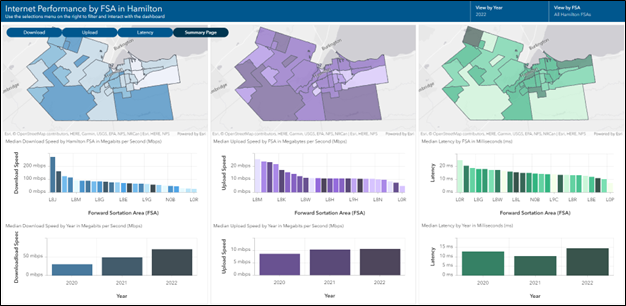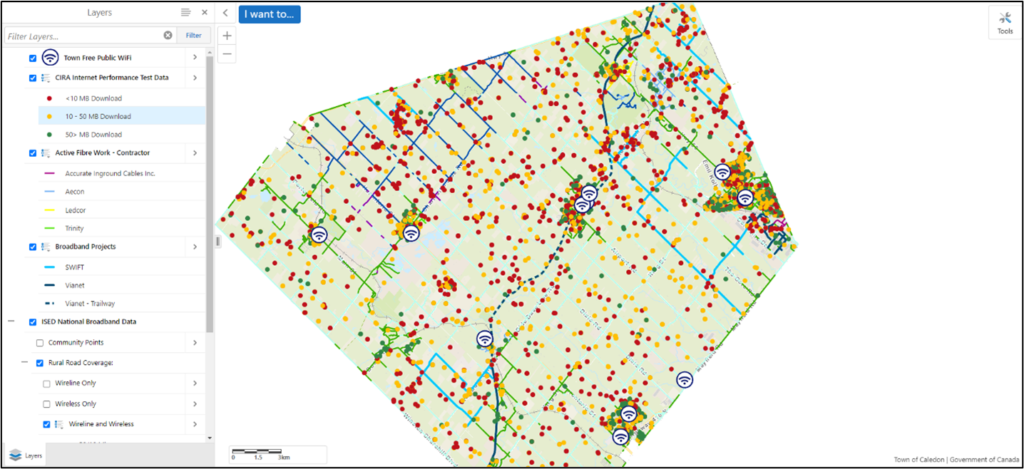More and more Canadian communities are taking direct action to close the broadband connectivity gap and data on coverage can help a great deal. CIRA’s Internet Performance Test (IPT) provides accurate, granular and highly sortable data for communities to benchmark connectivity levels today and measure progress in the future.
The IPT is an off-network internet speed and quality test that runs from the test-taker’s device to test nodes located in Internet Exchange Points in six major Canadian cities. Once initiated, the test takes about 30 seconds to run providing a read out of upload and download speeds, latency, jitter and packet loss. This data is also captured in our database, anonymized and made available to researchers, policy makers, economic development groups and communities that participate in our broadband performance testing program.
Through the community broadband performance testing program, communities get their own custom-branded municipal testing portal accessed via a unique domain name. Testing portals allow users to run tests and present the speed in a specific area using heat maps organized by established neighborhoods, wards, or any other established sub boundary. Communities are also able to take the anonymized data and display it, visualize it and compare it to other data, using a variety of unique and interesting approaches. Here are a few examples that have caught our eye.
City of Hamilton
The City of Hamilton recognizes the key role that high-quality, affordable broadband plays as a driver of economic and social growth. The Internet in Hamilton page pulls together useful information for Hamiltonians about internet/broadband access in the community, as well as the option to conduct speed tests of their connection. This webpage provides interactive mapping for the community to find free public Wi-Fi locations, a list of internet service providers (ISPs), as well as programs that fund and support digital equity. This includes CIRA’s own Grants program and the City’s pilot Digital Equity Grant, available as part of its Community Enrichment Funding program.
The City has been accessing performance data from the IPT for several years. They have used this data in the development of a new interactive map that visualizes upload speed, download speed, and latency by Forward Sortation Areas (i.e. the first three letters of the Postal Code). This interactive experience does an excellent job of illustrating how broadband access across the City of Hamilton has improved over time. On the flip side, the user can clearly identify that not all areas in Hamilton have access to broadband of equal quality. The goals of the tool are to help visualize connectivity across the city, create awareness and help promote and advocate for continued investment in broadband for the region – especially in underserviced areas.

Figure 1: Internet Performance statistics summarized by Postal area on one of Internet in Hamilton’s web maps.
Connectednorth.ca
Blue Sky Net has been collecting broadband service information for Northern Ontario for over 10 years. To present a clear picture of service availability directly to consumers, Blue Sky Net has created connectednorth.ca. The information is presented mostly in a map format through what is called the Ontario Internet Access Map or OIAM. This is useful for individuals, communities, economic developers, organizations and researchers alike who are looking for broadband infrastructure information and services.
The OIAM located at connectednorth.ca visualizes data in unique ways, displaying federal government broadband availability and service levels, federally and provincially announced broadband projects, lists of ISPs by region, as well as maps of summarized IPT data. The OIAM also encourages visitors to their site to contribute to this data by running a test through IPT. You can learn more about the OIAM in their annual report found here.

Figure 2: Aggregated IPT data in northern Ontario as shown on the OIAM
Caledon Broadband Map
The Town of Caledon has been pursuing a plan to bring high speed internet service within reach of all residents and businesses. Community engagement has always been an important aspect of their approach to closing the digital divide. In 2019, more than 2,000 residents signed a petition declaring access to broadband as an essential service and asked their local member of provincial parliament to support their efforts in bringing affordable and reliable broadband to Caledon.
Since 2019, things have vastly improved for the community through access to funding and partnership with internet service providers that have built and expanded fibre access. Caledon is using a public Geographic Information System (GIS) to map the progress. Layers on the map available to view are locations of public WiFi hotspots, federal broadband availability map data–including road level broadband speeds, funded broadband projects, the status of contractors actively laying fibre and the IPT results collected in the community.
The Caledon Broadband Map facilitates transparency between the community and residents. The IPT data in particular has also assisted the Town of Caledon in developing their business case for working with service providers and government funding programs alike. The Town of Caledon has harnessed the power of GIS to allow layers of information to be displayed at the same time on a map so users can see the interactions between the data.
Jeff recently joined CIRA as the Internet Performance Test (IPT) Program Manager. The IPT is the most advanced internet quality test in Canada that provides public access to the performance results. Jeff is an avid advocate for how IPT data, maps and reports can help stakeholders identify areas with limited access, improve funding decisions, evaluate the success of funded projects and do so at a high degree of geographic granularity.






